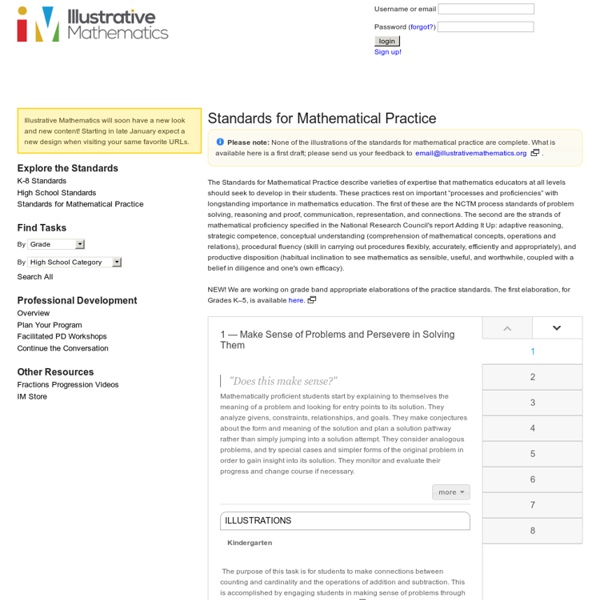Standards for Mathematical Practice

Home Page
Teachers Primary Pupils Secondary Students Events and PD "It gave me some good ideas to use in the classroom and ... a link that I can get all of the activities from." Book NRICH Bespoke PDBook Forthcoming EventsBook our Hands-on Roadshow Your Solutions
Common Core Curriculum | EngageNY
In order to assist schools and districts with the implementation of the Common Core, NYSED has provided curricular modules and units in P-12 ELA and math that can be adopted or adapted for local purposes. Full years of curricular materials are currently available on EngageNY for grades Prekindergarten through 12th grade in Mathematics and Prekindergarten through 12th grade in English Language Arts (ELA). How can I provide feedback on the curriculum modules? If you have any feedback on the curriculum modules, let us know by completing the Curriculum Feedback Form. We will review all feedback as we continue to make improvements to the materials. Guidance on Integrating Curricular Materials into the Classroom The optional curricular materials on EngageNY are designed to be adopted or adapted. Lessons are adaptable and allow for teacher preference and flexibility so that what is happening in the classroom can both meet students' needs and be in service to the shifts and the standards.
BlueHarvest - Standards-based grading and two-way feedback organization
3-Act Problems | Teaching Outside the Norm
Log in
When you hear a teacher's stories of classroom instruction, you hear the wisdom of practice through those stories. Classroom stories are a valuable repository of practical knowledge. At LessonSketch we believe that those representations of practice may also provide context for developing capacity for instruction.
turnonccmath
Formative Assessment Lessons (beta)
Read more about the purpose of the MAP Classroom Challenges… Mathematical goals This lesson unit is intended to help students to: Add and subtract directed numbers (positive, negative and zero) with understanding.Address common misconceptions about the addition and subtraction of directed numbers.Explain their reasoning using diagrams. Introduction This lesson unit is structured in the following way: Before the lesson, students work individually on an assessment task designed to reveal their current understanding. Materials required Each student will need a mini-whiteboard, pen and eraser, some blank paper and copies of the assessment tasks Directed Numbers and Directed Numbers (Revisited). Time needed 15 minutes before the lesson, a 90-minute lesson and 15 minutes in a subsequent lesson, or for homework. A draft Brief Guide for teachers and administrators (PDF) is now available, and is recommended for anybody using the MAP Classroom Challenges for the first time.
Science to the Power of Art | an exploration of the artform that is science
Tools
Bill, My wife and I are currently assisting the Amphitheater School District with the training of their teachers from grade K to 6 on the Common Core Standards. We would love to have links in our PowerPoint presentations and PDF files (both of which we give to the teachers attending our classes) that went directly to a portion of the text or an illustration that we would like to provide as part of our lesson. For example, teachers have a hard time understanding the division of a fraction by a fraction. The 6.NS Traffic Jam illustration provides an excellent means of giving teachers some intuition about the division of fractions. The problem is that I see no way to link to this illustration directly, or any text with the illustrations. Robert Springer
Algebra 1 Teachers - Resources for implementing Common Core math. : Common Core Assessment Examples for High School Math
We have all been told to begin with the end in mind. What do the kids need to learn? What is important? We then create the lessons to support that end. But what is the end according to the Common Core? Having an idea of what these future Common Core assessments will look like will give us the best chance to prepare our students for success. Understanding the Assessments Gotham Schools posted a sample of slides showing old and “new” assessments to compare and contrast. Sample Performance Tasks I love the idea of performance tasks. PARCC has released sample tasks for their assessments.This is a wonderful collection of performance tasks to get started with. The library of over 300 mathematics assessment tasks developed during the project remains freely available through this web site. 101questions is a great site for peeking student interest in questions that they come up with themselves. Sample Common Core Assessment Questions These can be hard to find for the high school level. Whats Next?
Related:
Related:



